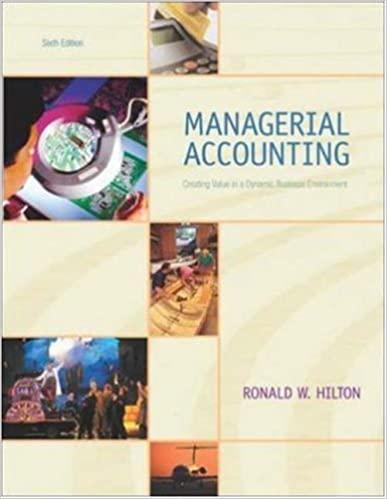Answered step by step
Verified Expert Solution
Question
1 Approved Answer
i will give thumbs up to those who will answer all questions. Variable and Absorption Costing Emerald Corporation uses the FIFO method to track inventory.

i will give thumbs up to those who will answer all questions.
Variable and Absorption Costing Emerald Corporation uses the FIFO method to track inventory. The records for Emerald include the following information. For simplicity, assume that the amounts given are both the budgeted amount and the actual amounts and thus, there were no variances. Inventory Beginning balance, in units Production Available for sale Less units sold Ending balance, in units Year 1 0 12.000 12.000 7.800 4,200 Year 2 4,200 10.000 14.200 12.000 2.200 Other information Sales (P2.10 per unit) Variable mfg. costs (P.90/unit) Fixed mfg. costs Variable selling and admin. costs Fixed selling and admin. costs P 16,380 10,800 5.000 2.250 2,250 P 25,200 9,000 5,400 3.750 3,750 Required: Prepare the income statements for Year 1 and Year 2 using both the absorption costing and the variable costing methods. Responsibility Accounting The costs of the invoicing function of ABC Corporation are allocated internally to the three sales regions of the company for the purpo of performance evaluation: Western Region, Central Region, and Eastern Region. Costs include the invoicing clerk's wages, office supplies, and fixed asset costs such as a desk, a computer, a file cabinet, office space, and a telephone. The clerk's wage is $15 per hour, which is a variable cost because the clerk works only the number of hours necessary each day to complete the day's invoices. Office supplies (such as invoicing stationery) and other necessities (such as printer ink) have been assessed at $2 per invoice. Fixed asset costs are $2,000 per month. During May, the invoicing clerk worked 130 hours and prepared 1.800 invoices: 900 for the Western Region, 500 for the Eastern Region, and 400 for the Central Region. Required: Allocate the invoicing costs to the three sales regions using the following methods: a. Stand-alone cost allocation system b. Incremental cost allocation system Transfer Pricing Bill Corporation has two divisions, A and B. Division B currently operates at 100% of its capacity and produces two products: widgets and gadgets. Division B sells both products to outside customers for P15 and P30 per unit, respectively. The variable costs for the widgets are P10 per unit and fixed costs are P3 per unit at the current production level. For gadgets, the variable costs are P16 per unit and fixed costs are P8 at the current production level. Division A, which currently purchases widgets from an outside supplier for P16 per unit, would like to purchase 150 widgets from Division B annually. However, Division B increases the production of widgets to meet the demand of Division A, it must stop producing gadgets entirely. Also, to meet stricter quality requirements of Division A. Division B must increase materials costs by PO.80 per widget, but the marketing and transportation cost per widget will be reduced by P0.50 per unit. The total number of units of gadgets produced and sold by Division B is 50 units per year. What is the price range within which the transfer price widgets would satisfy both divisionsStep by Step Solution
There are 3 Steps involved in it
Step: 1

Get Instant Access to Expert-Tailored Solutions
See step-by-step solutions with expert insights and AI powered tools for academic success
Step: 2

Step: 3

Ace Your Homework with AI
Get the answers you need in no time with our AI-driven, step-by-step assistance
Get Started


